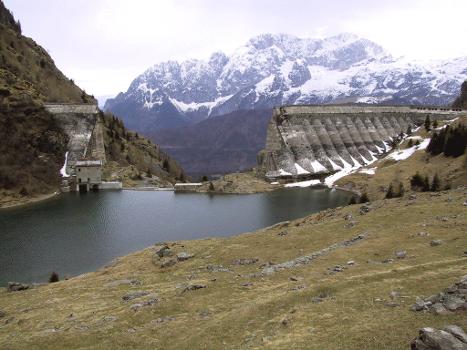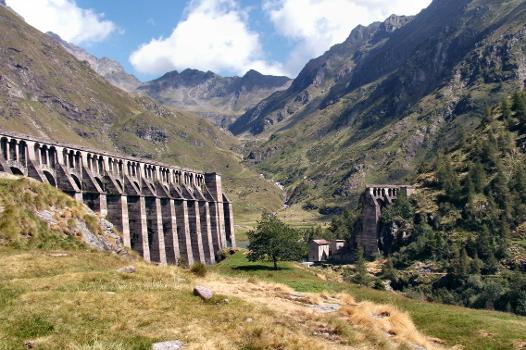General Information
Project Type
| Structure: |
Buttress dam |
|---|---|
| Material: |
Concrete dam |
| Function / usage: |
Hydroelectric dam / plant |
Location
Technical Information
Dimensions
| height | 52 m | |
| retained water volume | 3 900 000 m³ | |
| crest length | 260 m |
Excerpt from Wikipedia
The Gleno Dam was a multiple-arch dam on the Gleno Creek in the Valle di Scalve in the northern Province of Bergamo, Italy. The dam was constructed between 1916 and 1923 with the purpose of producing hydroelectric power. A portion of the dam failed and burst 40 days after ist reservoir was full, on December 1, 1923, killing at least 356 people.
Background and construction
The dam was proposed and constructed by the Viganò family. A request to construct the dam was submitted in 1907 and initial construction began in 1916. In 1920, construction began on the dam's foundation and in September of that year, local officials were warned that contractors were not using proper cement mortar. In 1921, because of funding, the project design was changed from a gravity dam to a multiple-arch type. The design was approved and the multiple arch dam would be constructed on top of the gravity dam foundation. In January 1923, the dam was 80% complete and by October 22, it was fully complete and ist reservoir full after heavy rains. The dam's power plant had an installed capacity of 3,728 kW (3.7 MW).
Failure
At 6:30 on the morning of December 1, 1923, a buttress on the dam cracked and subsequently failed. Within minutes, an estimated 4,500,000 m³ (3,648 acre⋅ft) of water gushed from the reservoir at an elevation around 1,535 m (5,036 ft) above sea level to the valley below. The village of Bueggio was flooded first, followed by a partial flooding of Dezzo part of the municipality of Azzone and complete flooding of Dezzo a frazione of Colere and Corna di Darfo. The flood waters were stopped when they reached Lake Iseo which lies at an elevation of 186 m (610 ft) above sea level. At least 356 people were killed in the disaster.
Cause of failure
The dam was originally permitted as a gravity dam with a slight curvature, but was changed to a multiple arch dam by the client to save money. The permit was not revised for this change until after the dam was completed. The failure of the multiple arch dam was attributed to many aspects of ist construction, ultimately poor workmanship. The concrete in the arches was of a poor quality and it was reinforced with anti-grenade scrap netting that had been used during World War I. There were also indications that the dam was poorly joined with ist foundation. Additionally, the concrete was believed to not be completely cured when the reservoir was filling. Reportedly, workers who complained about the construction techniques were fired. Today a memorial exists in the failed gap along with a much smaller dam and reservoir within the old reservoir zone.
The dam's failure was influential in the development of Italian dam design and risk assessment. As a result of this failure, the construction of new multiple arch dams has become disfavored.
Text imported from Wikipedia article "Gleno Dam" and modified on July 23, 2019 according to the CC-BY-SA 4.0 International license.
Participants
Currently there is no information available about persons or companies having participated in this project.
Relevant Web Sites
Relevant Publications
- (1924): La rupture du barrage du Gleno. Étude descriptive, critique et analytique. In: La Houille Blanche, v. 21, n. 2 (February 1924), pp. 34-47.
- About this
data sheet - Structure-ID
20042901 - Published on:
10/01/2009 - Last updated on:
01/03/2015






